Mason & Dixon - Part 1 - Chapter 22: Understanding the Vortex
Analysis of Mason & Dixon, Part 1 - Chapter 22: Maire and Emerson Waiting, DePugh and Co. Discuss Brainwashing, Ley-Lines, Emerson's Goodness, Dixon with Maire and Emerson, the Henry Vane Analogy
Back with Dixon, we find him up north of London sometime after he and Mason were interrogated. Father Christopher Maire is waiting for him in William Emerson’s parlor. As a reminder, William Emerson was the mathematician who was Dixon’s mentor. Dixon mentioned Emerson in his first correspondence with Mason to try to impress him with his qualifications (1.2). Christopher Maire was a Jesuit, a friend of Dixon’s, and a writer of numerous works on astronomy. Back when Dixon had returned without Mason to Cape Town, the Dutch mistook his friendship with Christopher Maire for the Le Maires, a powerful and notorious VOC family. This mistake allowed Dixon to get out of Cape Town with no harm done to him despite the conflict of interest that he posed to their research (1.14).
Emerson is characterized as a wizard, being not only a mathematician and teacher, but a proponent of the ‘Dark Arts,’ performing acts such as horoscope readings similar to how Maskelyne and Mason did on Saint Helena (1.13). Maskelyne was notorious for conducting horoscopes, though his reasoning for this was to profit off of the ignorance of the population who would conflate astronomy with astrology — a science with a magic. And though we have been discussing the necessity for the acceptance of the magical and spiritual realm within our material world, there is a massive difference in using it to exploit the ‘ignorant’ as opposed to becoming more in tune with Earth. Maskelyne clearly used it for the former; Emerson, given his practice has been characterized as Dark Arts and ‘mesmerizing’ certain unsuspecting individuals, is possibly doing it for the same. But let’s look further before coming to that conclusion.
As stated in Biebel’s companion, in regard to Dr. Mesmer, “Franz Mesmer is best known for the phrase ‘animal magnetism’ [and] […] The name’s also associated with hypnosis” (Biebel, 18).1 The connotation here almost certainly has to do with hypnotism — perhaps a reference to the fact that many important scientists and men in power have incorporated a form of brainwashing into their teachings, masked as a type of wizardry. They will put up the facade that this magic is a progressive and necessary path forward, but will, in the end, both commodify it and use its power to warp the minds of free thinkers.
Back at the LeSpark’s house, DePugh has returned.2 He comments on this portion of Cherrycoke’s story, mentioning how he too was once hypnotized by Doctor Mesmer, spending upwards of eighty-five pounds for this privilege. So, not only are our citizens being brainwashed by more powerful individuals, and not only are they being brainwashed with full consent, but they are paying absurd sums of money to do so. There has been a commodification of willful ignorance weaving its way into the ‘lesser’ ruling class, into the sons of brothers of arms dealers who will likely never make it to the place that their distant relatives have, but who will inevitably excuse those actions and who will refuse to admit that they literally bought into this train of thought.
DePugh adds that he is thinking of “setting up a [similar] practice in America,” (216) to which Brae recommends doing in New York, setting off a massive series of arguments. To begin with, Brae’s suggestion of setting up this ‘practice’ in New York is likely innocent. To her, still a child, this act seems to be the genuine practice of harmless hypnotism rather than a nefarious brainwashing. New York, to her, is the epicenter of communication and information distribution. Knowing this, she believes that his practice can be best advanced in a place such as New York — and she is correct. Think of The New York Times pretending it is a bastion of progressivism, having the audacity to informally label itself as left-wing while spewing neoliberal propaganda to readers who believe they also resemble something half-way left-wing. New York really is the perfect place to gaslight the populace into believing that your beliefs are the ones worth following.
J. Wade believes differently. Being an arms dealer who is so far right wing that (if he lived in a time that these terms were common) even neoliberalism appears to be communism, he thinks this ‘mesmerizing’ can be achieved anywhere. To prove his point, J. Wade brings up Mr. (Timothy) Tox, a fictionalized hypersentimental poet who lauds and extols the inherent possibilities of the American frontier.3 Tox, here, states that small town America is just as good a place to accrue wealth through something known as Pelf: “Money earned by graft/corruption” (Biebel, 100). And if you could imagine, the hive mind that tends to exist in small town America is a great spot for brainwashing to occur.
DePugh brings up the fact that he was thinking more of the Western frontier where new possibilities lay abound — where “opportunities await the alert Practitioner, among Red, even as White, customers” (217). This expanding ‘westward’ is the promise that capitalism will engender a source of progress through competition. Traveling West will bring the need for industry small and large… the need for long distance travel via trains, automobiles, and eventually planes… housing developments urban, suburban, and rural, single-family homes, apartments, multi-family dwellings… agriculture on a scale never before seen. The belief is that the furtherance of modern capitalism will allow for this progress like nothing else could. What J. Wade or other industry tyrants would want the general population to believe is that progress at the scale it is needed here would never be possible without competition. They would pose questions such as: why would transportation tycoons feel the need to improve the speed or quality of their products if they were the only option for transportation in the first place? Why would farmers seek to make a higher quality or tastier food if their food was all that was available? Why would landlords or builders seek to maintain the aesthetics or upkeep of their buildings if they were the sole provider of housing?
The truth lies in two different realms. First, American expansion was never built on the idea of mutually beneficial competition in the first place. While competition did come out of it, this was due to the desire to one up the other industry-man in order to become that person who people come to for whatever product they may be selling: “Hence our zeal in defending Monopoly” (217). This would lead to the formation of monopolies, completely subverting the concept of competition. So, secondly, with the formation of monopolies, as Ives says, “‘Nobody here wants Competition […] All wish but to name their Price, and maintain it, without the extra work and worry all these damn’d Up-starts require” (217). Capitalism will come to be regulated by a supposedly beneficent law banning the monopolization of certain sectors and industries, allowing for competition to flourish. This ruling, however, will eventually fall by the wayside, subject to misinterpretations, semantics, and, though it is with a feigned naïveté, a complete disregard of its existence. This therefore leads to the capitalists themselves to brainwash (‘Mesmer-ize’) the public in incorrectly defining the goal of capitalism (i.e. competition for technological progression) while subverting this goal entirely (i.e. monopolization of industry for maximized profit) and then further brainwashing the public by passing laws to do away with the stated subversion of the goal which they had no intention of following in the first place.
All of this brainwashing is often done without our knowledge. However, like DePugh, many will often accept this brainwashing willingly — and sometimes even pay for it.
Cherrycoke continues his story back with William Emerson, the so called Dark-Arts magician whose name began this anecdote on brainwashing. We see a scene of him far in the past teaching students, Dixon included, how to map Ley-Lines — perfectly straight topographical lines which were said to connect historical structures due to ancient cultures being more ‘in tune’ with the ‘magic’ of the natural world, thus allowing them to ‘sense’ these lines and build the structures on them accordingly (Biebel, 101). Emerson, here, is taking on this ancient, mystical task and is teaching the students how to map these lines, though given that the end result of his teachings was Dixon (and likely many other of his students) becoming a surveyor who mapped the boundaries of private properties and counties in England, his desire to impose an understanding of the world’s magic was trumped by him consciously or unconsciously brainwashing his students into believing in the natural existence of abstract borders. And by the end of his teaching, as Dixon tells Mason, Dixon “knew [he] could feel those Lines” (218).4
Conversations on these Ley-Lines continue in a variety of forms: Mason and Dixon, in the future, discussing how Mason also has heard how these lines connect sinister structures; Emerson’s students associating the Earth with something that is to be naturally mapped and sectioned off into districts and counties and states and countries; Emerson himself conveying to his students the power and necessity of both sensing and mapping perfectly straight lines. His advocation for straight lines also mimics many of the LeSpark’s lust for straight historiographic paths — paths of history with no nuance and no wildly coiling events all leading to a specific end goal or inciting event.5 Brainwashing thus seems to have an inherent or inseparable connection with this idea of a straight line or straight path forward. 6
And who better to be best in tune with ‘straight lines’ than those who had discovered the earliest Coal-Pits: the Mithraists.7 This discovery would set off a world-wide trajectory toward the necessitation of coal, oil, and other fossil fuel compounds long dead now destined to bring further death upon the Earth.8 Its discovery was obviously not done with the intent to bring such colossal atrocities to the Earth; however, if the Mithraists were said to have such immense mystical knowledge about the Earth’s workings, why would they not know something such as this. Would the reason they brought the mapping of straight lines be to increase the discovery, accumulation, processing, sale, and use of coal or other fossil fuels and petroleum-based products? Well, historically, probably not. It’s a ridiculous and comical accusation to blame the Mithraists for our contemporary worldly ills. However, the thematic value remains: coal and oil distort the complexity of our history into a linear path forward. Wars began in the Middle East for reasons delineated by the State and by the press, but the inner-workings of the so-called Mithraists (now being a thematic entity representing secret societies within the ruling class) advance the ideology of straight lines — of Ley-Lines — so to warp our understanding of what actually led to the conflict now occurring.
All of this negative talk on Emerson is relevant, though he is a more complex character than being one who is only there to brainwash; in reality, much of what he teaches may not even be intentionally meant to brainwash his students or the public. It could simply be what he was taught, or even the conclusion that he came to based on the method which he was taught or the desires that society led him to seek. Because as we can see here, while he may very well be proposing the use of linear paths forward in their field of study, he also finds that he “loves Vortices” finds that “Winds are imagin’d to be forms of Gravity” (220)
This brings us to the point of the whole section. For without this scene, we would have observed Emerson purely as a nefarious character; but in reality, he is the representation of our modern schooling system — one which has good intentions and yet leads its students astray. Because if Emerson’s teaching involved the Dark-Arts, the mapping of abstract borders over natural land, the call-back to coal’s discovery, then why would he call Dixon a fool for desiring to become a surveyor upon the conclusion of their course of study? Dixon even asks him: “Why then advise me, as tha did from the outset, that my Destiny was to inscribe the Earth...? Why show any of us the Leys as tha did, and the great Roman streets[?]” (221). Emerson’s response, as he said, was “To weed out you who are too content with Spectacle” (221). But this all seems too simplistic, so let’s take another step back.
Firstly, Emerson was obsessed with Vortices, the literal antithesis of linearity. Having been trained long ago, his own academic path led him to see how the complexity of minor historical events would blend, leading to the emergence of major historical events. In the same way, no field of mathematics — be they Fluxions (derivatives) in calculus or the emergence of Logarithmic scales — could possibly emerge without the entanglement of multidisciplinary study. These numerous webs and points would begin their spiral inward, inevitably meeting another one that would make no connection and occasionally one that would radically alter the world’s knowledge. For example, thinking of Gravity’s Rainbow (3.11), how else could Kekulé have discovered the chemical structure of the benzene ring without having knowledge of the Ouroboros, despite chemistry and the humanities not having that apparent a connection otherwise?9 Secondly, Emerson saw the Wind as a ‘form of Gravity.’ The Wind, as seen on Saint Helena, was the forward trajectory of history (and often the endless possibilities that history could ever entail). Gravity calls to mind Gravity’s Rainbow, where it itself was the force of nature which certain members of humanity sought to overcome in order to elevate themselves as gods. So, if the wind was merely a form of gravity, then what Emerson saw was history being another conquerable aspect of the world whether he believed this to be something commendable or not. And in his analysis of the conquest over history, he is also seeing how Fluxions (i.e. mathematical derivatives in our modern vocabulary) are related to this idea. A derivative tells us the slope of a line on one specific point of a curve (as opposed to an integral which gives us the area between two points under the curve). This knowledge, paired with that of integrals, could show those who want to control history just how close they were toward achieving their goal. For, as the slope increases and holds steady, traveling up the curve, we see their goal increasing and the area under the curve drastically rising. Something good is coming for those who will benefit from this inciting event. And then, as the parabola begins to reach its peak, as the slope begins to level out toward zero, They will know when to set everything in motion. When the slope is zero, all hell breaks loose, and They are on their way to gaining everything they could ever desire. For everything afterward is Beyond the Zero.
Emerson is aware of this. He knows the unfathomable number of events that lead to one moment of history and knows how those in power wish to control those events to reach the exact center of the vortex that they desire. So why then does Emerson teach something different? Why does he teach them of linearity, inevitably leading them to contribute to the Elite class’s goal of controlling the people, the nations, and, ultimately, history itself? The simple answer is that this is just how the education system functions. Educators are often well-intentioned, but how frequently do we really see them teaching about vortices rather than lines? Obviously, the line must be taught first or else there would be no hope that the student could comprehend the vortex; it is like learning arithmetic before algebra. Or is it? Mathematics may very well require this sort of structure, but history, and the politics of control do not. On top of this, there is danger in teaching of something like the vortex. If the word got out, you would likely not be a teacher much longer. And finally, in Emerson’s case, it may just be him relenting to the way things are done: A comes before B, which comes before C, and so on. Of course, ‘the way things are done’ has also been set up in such a way for more reasons than to merely benefit the student; it benefits those who set the system up as well. All of these reason, and likely more, are why Emerson conducted his teachings as he did.
And to clarify for those who are not seeing the analogy: this is not an advocation for doing something as stupid as learning about calculus before learning arithmetic, or learning about Freud’s theories before learning how to write your name. The analogy merely tracks that pushing for one train of thought endlessly without even hinting at further knowledge will inevitably lead the student toward treating that initial idea as sacrosanct, making it more difficult to accept an entirely new world view without consciously striving for it.
Back in the present to when Christopher Maire was in William Emerson’s parlor, waiting for Dixon, the three have all arrived and are sitting together at a table. Emerson, here, may be attempting to undo some of the unintentional brainwashing which he subjected Dixon to much earlier in life. Their conversation truly begins picking up speed when the Goose and Gridiron, a Masonic Lodge, is mentioned in conjunction with someone named Ruggiero. This is Roger Boscovich, a Jesuit priest who also dabbled in fields such as astronomy, mathematics, philosophy, physics, diplomacy, and so on. While he was not believed to be a Freemason, this does not mean that the mention of Freemasonry here is irrelevant or coincidental. For, given the Freemasons at the time were a group home to some of the most powerful men in the world — the true Elites — they would likely use, fund, or attempt to get anyone at their disposal to act according to their will, whether it was known or not. In this case, Boscovich desired “to measure a Degree [of Latitude] in America” (223). Well, this simple task, even just settling for a ‘fraction of a Degree,’ is in line with Emerson’s initial teaching of straightforward — point A to point B — Ley-Lines. Seemingly innocuous findings which had enough magic to awe the discoverer, preventing them from looking further into what may really be going on.
In this case, while Boscovich’s point may just be one short degree of latitude, all of this has added to the coming accumulation of “a Web, all over the World” (223). When further measurements are made, when ‘observatories’ are spread across the surface of the globe under the pretense of scientific discovery, when each of these observations gives Them (be they the Freemasons or another Elite group) more reach around the Earth, then They will certainly be happy to fund a mere small endeavor. There is always an alternative motive. Here, Emerson states, “the inner purpose […] can only be,— to penetrate China” (224).
An odd conclusion, but not that odd if we were to look at our modern world. Taking the literal China out of the picture for just a moment, very often the scheme of the Elite class is to penetrate, infiltrate, or simply control a foreign entity. Spreading a ‘Web’ of accepted outposts around the globe — in the same manner as spreading American Military bases around the globe — is an unfortunately brilliant way to do this. So, Emerson’s conclusion that the point of all this is to penetrate and thus control a foreign nation is certainly not a reach. China is specifically brought up likely due to Pynchon’s ‘future’ knowledge that much intelligence and technology will be used specifically to try to best China, to propagandize our nation against China, and to attempt to bring China down as a competitor in the global market. Though it does also make sense in the context of the time seen early on in Part 2 (2.28) — but we’ll get to that when it comes.
In the end, we see that Emerson and Maire are aware of Dixon himself being propositioned to go to America to map a new border. Maire discusses this with Dixon through the use of an allegory, comparing Dixon to someone from the mid-17th-century named Henry Vane the younger. The allegory goes as such:
The Jacobites remained in America, and the dispute that led to them being there “did not end with Cromwell, nor Restoration,— nor William of Orange, nor Hanovers” (226). Each of these orders rose up to reinstate a Tradition that existed in the past. Henry Vane attempted to change the way of things in 17th-century England, ultimately being beheaded, leading to a new ‘monarch’ named Oliver Cromwell. Cromwell was a monarch in the 1650s who simply did not label himself as a ‘monarch.’ In reality, he most definitely was. Eventually, after his death in 1658 and after a few years in a political vacuum, the Restoration occurred with the new monarch being Charles II. Cromwell’s body was exhumed — his head mounted on a spike for decades on display. However, this so-called restoration is where our society gets its modern definition of the word ‘cabal.’ Five of Charles II’s advisors, whose initials spelled the word ‘cabal,’ ran the true show behind-the-scenes as a sort of shadow government. Once again, the same thing under a different name — just how Cromwell was a monarch but claimed not to be. Following Charles II came James II (not mentioned above) who only reigned for three years. But more importantly, after James II was exiled in the Glorious Revolution (1688), William of Orange (also known as William III) took the throne. Obviously if a revolution were to usurp a king and install a new monarch, this monarch must be different, right? Well, kind of in some respects, but not really overall. Sure, he passed progressive reforms moderating the power of monarchs and allowing for more religious freedom; however, his expansion of the EIC allowed for global imperialism to expand to the state that Mason and Dixon saw it occurring in Cape Town and elsewhere. After William’s reign (lasting from 1689-1702), Queen Anne (also not mentioned in the above quote but who was the daughter of James II) ruled from 1702-1714, and was herself succeeded by George I from the above-quoted House of Hanover. Hanover was a German city rather than an English one, which obviously would have caused some uproar. He was only chosen due to nepotism given he was related to Anne and that she had no direct successor otherwise, leading to a foreign government ruling over a nation — sound familiar?
This order — one ruler taking the reins, stating they will enact change, but inevitably doing more of the same — “is now remov’d to America” (226): a country which will rise on the pretense that it is breaking the traditional mold of power and yet is merely bringing that tradition back under the guise of freedom. Dixon, being compared to Henry Vane, will not directly contribute to the attempted overthrow of the system, but will indirectly do so. He will think he is doing good and yet will be tossed out after his purpose is served. Little to his or anyone’s knowledge, this attempted overthrow will inevitably lead to the continuation of the same system which they currently still live under, just as it led to monarch after monarch in 17th-century England. And similarly, the EIC, the secret cabals, and nepotism in general, would not only continue, but would flourish more than they ever had. In all, Emerson concludes for Maire that to these people “human life figures as nothing,— that being all the secret to Governance upon Earth” (226).
Though Dixon won’t admit it, he will be just as complicit as Mason will be in the coming adventure to America. Emerson failed in teaching him correctly and tried to enlighten him of a better path forward. Maire did the same with the allegory of Henry Vane. But while Dixon has not made his decision just yet, we know exactly what he will choose. He will choose a country that will bring the same forms of brainwashing that the LeSparks discussed earlier using communication and information that will be spread in city centers and by hypersentimental poets like Timothy Tox — a country that thinks it is becoming the bastion of newfound freedom but is only bringing back the tradition of tyranny under a new name.10
Up Next: Part 1, Chapter 23
Biebel, Brett. A Mason & Dixon Companion. The University of Georgia Press, 2024.
DePugh has only appeared briefly before when the family was observing the Orrery. He was the son of Ives LeSpark, brother of Ethelmer, and nephew of J. Wade and Elizabeth. DePugh was the character who brought up the concept of a Vector of Desire (1.10).
Timothy Tox is a very important ‘character’ to remember. His use as a hypersentimentalist bringing Americans to believe that the American Dream is feasible for all, is one of the most effective forms of brainwashing, both in the time period that Mason & Dixon takes place and in our modern era with the romanticization of suburban life.
If you have finished the chapter by this point, you will obviously know that Emerson’s character is far more complex than just attempting to brainwash the students into becoming surveyors. But I am currently laying the groundwork for that analysis, so bear with me.
See 1.17 for a deeper discussion of these so-called ‘Inciting Events.’
It is also important to note the connection to some of Pynchon’s other works such as the train tracks in The Crying of Lot 49 representing preset historical paths that could be changed by the ‘pointsmen’ at will, or the circuit board that Oedipa envisioned (in Chapter 2 of the same novel) which symbolized the nature of roads that were built to only ever lead the driver from point A to point B and never anywhere in between.
Mithraism was a Roman religion (more like a cult) centered around the god Mithras, founded somewhere between the first-century BCE and the first-century CE.
A foreshadowing of Walther Rathenau’s seance in Gravity’s Rainbow specifically with his line, “from death to death-transfigured” (Gravity’s Rainbow, 1.19, pg. 166).
They do have a connection, obviously, but you get the point.
New Annotation added on August 2, 2025: Another insightful comment by CFM pinned below. Great thoughts on the references toward the Jacobites and China.


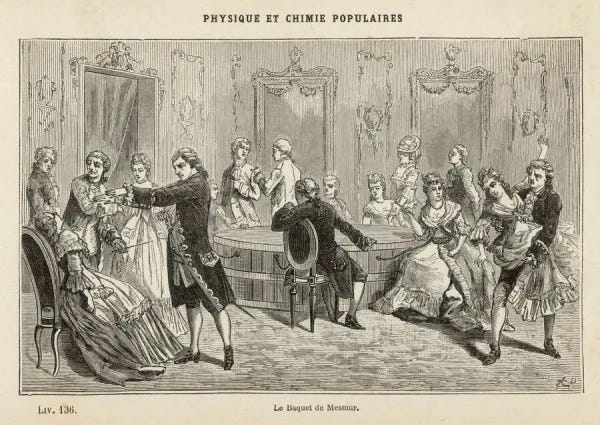
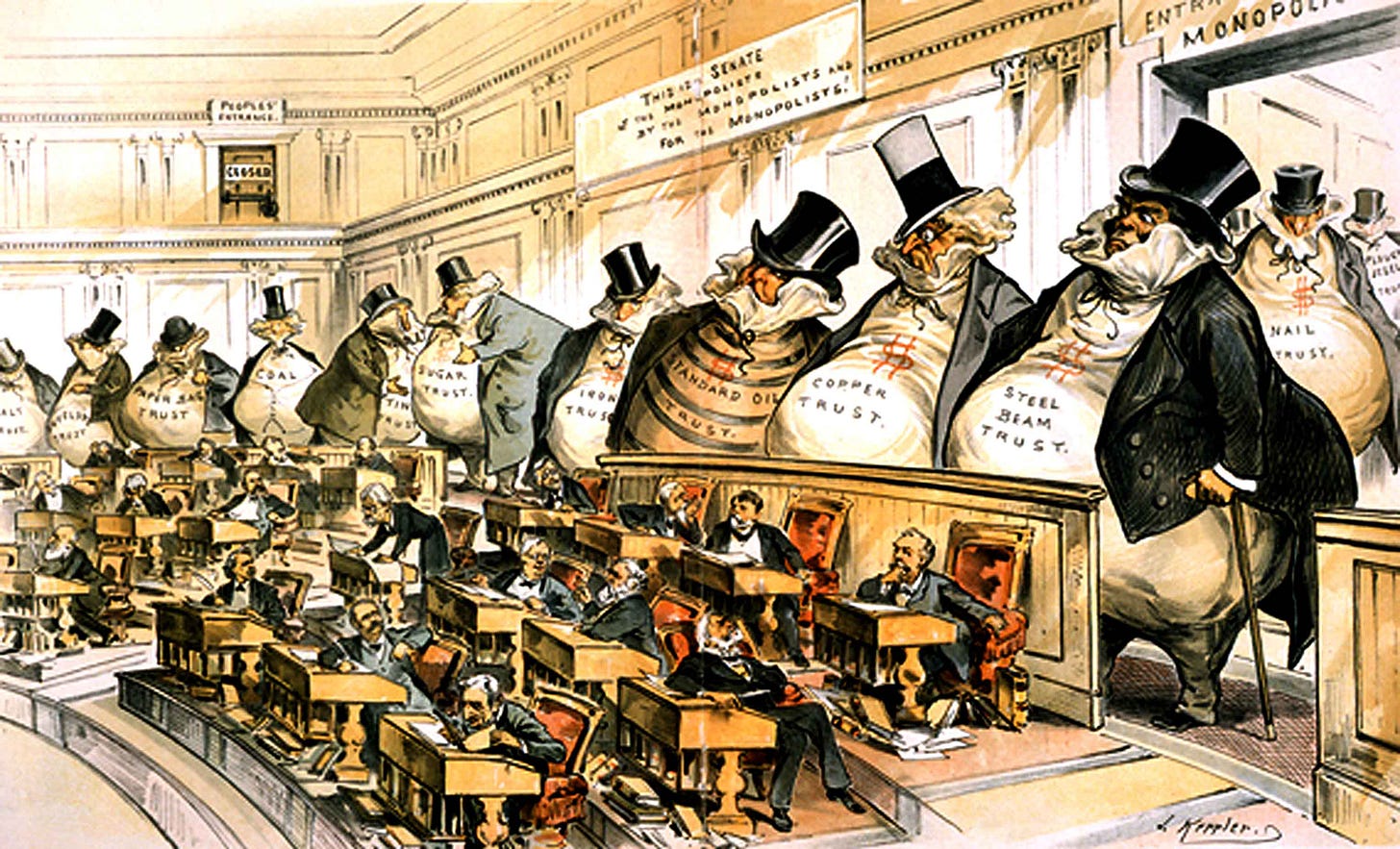
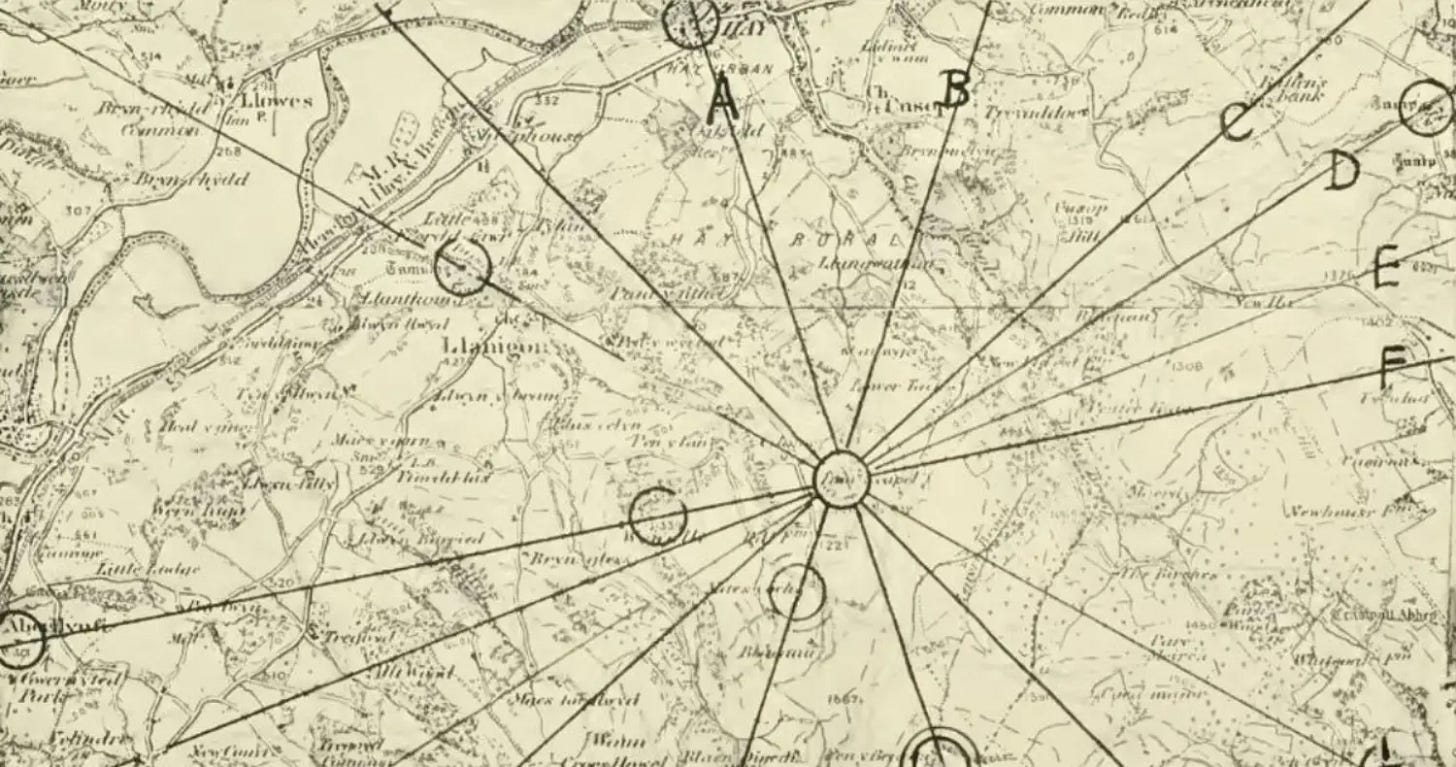
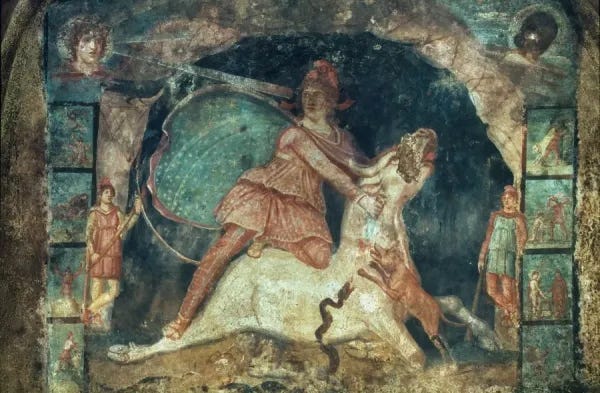
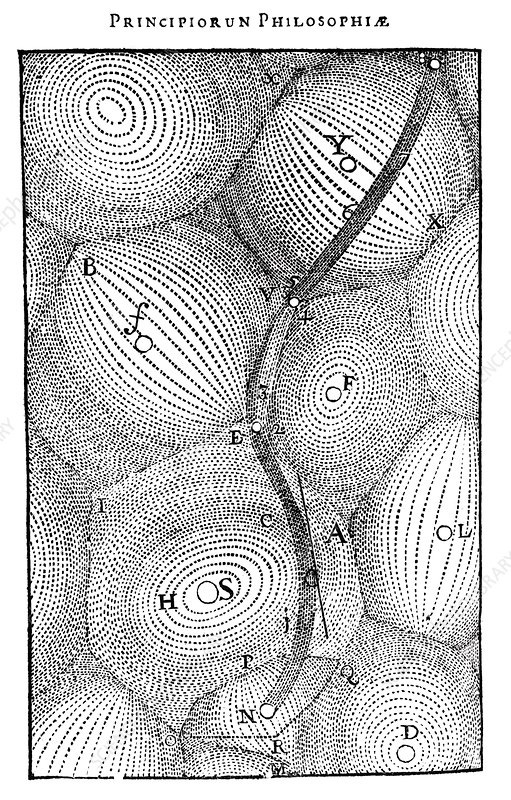

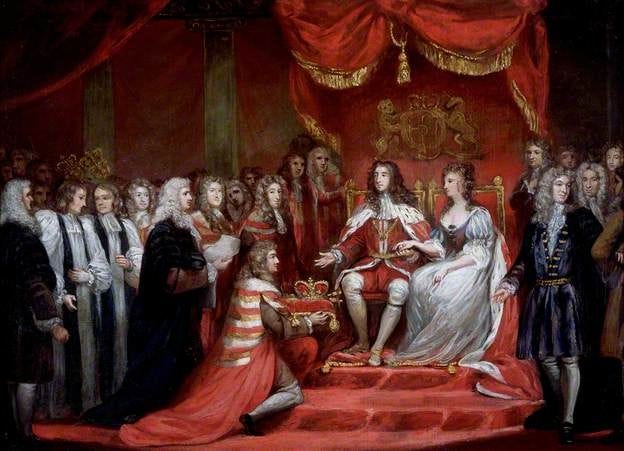
You really outdid yourself this week!
Just wanting to add on a little for fun possible connections.
Please correct me if I'm wrong regarding point 1, I'm not American or English, but found this interesting but I might not have as good a grasp of the Anglo-American history.
1.
Working through negative space is important when discussing the religious factions of the day. It's also incredibly time consuming. As in, what is left out when talking, especially in terms of uncomfortable history. (Such as being proven wrong or unable to argued about in favor of themselves)
It's important to reflect the the initial Mayflower pilgrims and first wave of religious outcast that formed the founding of the United states. Who then had the charter of Massachusetts being revoked, under Charles II. There is always another angle. In that revoking act, the initial settlers became a colony, without a choice. A colony to those who they initially fled from. When they become valuable.
The next half century slowly leading to their erosion of religious identity they had fled to preserve. Whether this was entropy of religious world at the time, or connections with the influence of the colonial link to the king is another enigma. Who benefits from it, is a better question maybe.
Cue the entrance of some Jacobite's being led from their country to the new world within the next 80~ years. When their rebellions did not go to plan. As political prisoners or servants.
So recapping:
The puritans and pilgrims, losing what they had to kings who caught up to where they fled. Whose supporters (the Jacobite's) eventually arrive to that new land (Not necessarily all, and not necessarily by choice for those who did). Arriving to a land, as victims. Joining the nation, whose ancestors were victimized by the kings the Jacobite's supported.
Stranger then fiction, and thus real. I think knowing Pynchon we have to keep that doubt in mind, when being told who said what especially among the religious of the era. Who definitely all knew their history. Not sure, if this is the right place to go this far into it, but your mention of the Jacobite's appearance in the US, made me reflect on this.
In the end, they ended up being in the same boat. Of whatever the powers at be decided they were to be. Supporting the very thing, that will punish you for being who you are. Even though it was what made them.
2.
I had something come to mind about the China conspiracy. The future control of China by foreign forces during the century of humiliation (Thus the penetration). Leading to the Boxer Rebellion which is in itself one of the greatest example of what you are alluding to. If not Pynchon himself. A tragedy and crisis of what imperialism becomes.
Which also had missionary Christians, having more rights in certain cases, and expanding their sphere of influence deeper into China at the time. Which was another of the instigating functions for the eventual Boxer Rebellion. Though there were so many, but one being anti-christian is key to this Jesuit conspiracy.
The boxer rebellion which in it’s struggle for freedom, unified many foreign powers to fight off the Chinese attempt at control of their own nation. China being viewed possibly as a greater threat that was currently successfully contained. (One of these foreign power being the US troops sent in.)
Leading to Chinese culture as a whole reflected in countries such as Taiwan, China and Singapore — to view drugs as a epidemic in which to subdue the masses and thus retain colonial or foreign control on them. Possibly? It was the case then, but overtime it might have evolved into a new logic, as drugs might have new significance in their culture’s today. Compared to a 100 years ago. They (Chinese) having been the victim of opium for so long. (Opium wars and Century of humiliation )
I remembered this tangent and found it too interesting thematically not to mention. Always hard to tell with Pynchon how far the thought should go. In terms of timeline.
3.
"And to clarify for those who are not seeing the analogy: this is not an advocation for doing something as stupid as learning about calculus before learning arithmetic, or learning about Freud’s theories before learning how to write your name. The analogy merely tracks that pushing for one train of thought endlessly without even hinting at further knowledge will inevitably lead the student toward treating that initial idea as sacrosanct, making it more difficult to accept an entirely new world view without consciously striving for it."
Very funny, made me laugh and absolutely real.
Not sure if it's faint connection or not, but the Anglican imposed religion, might have ties to what the Chinese had to endure? A quasi colony enduring missionary converting without much say due to imperial pressure?
But while the originally puritans got to flee, the Chinese had no choice but to rise up against this religious imposition. Almost inversed. No fleeing west, as the threat is coming from the west and you can only fight back or submit.
And thus the imperial power built from religious rebels forces down rebels to impose religion.
Which leads the Chinese to also flee into conditions of empire building for foreign powers, like the puritans forced to build, then reclaimed into myth (Sun Yat-Sen) or the American mythologising of a misremembered puritans. With the final image being that of puritans descendants seizing land, Jacobites descendents fighting for republic instead of kings, and the Chinese state becoming what they fought against. People being victims to their own decisions.
Went way too far replying. Thank you for the big chapter this week.
Have a good week and weekend!
Brilliant stuff this week. A couple of thoughts, if I may:
"Brainwashing thus seems to have an inherent or inseparable connection with this idea of a straight line or straight path forward."
It seems to me that it's not lines themselves that are condusive to brainwashing, but *the act of making them.* Let's not forget that Mesmer himself induced hypnotic states by making linear "'passes', moving his hands from the patient's shoulders down along their arms." (Wikipedia)
And later , "I have talked with several who have witnessed these effects, who have convulsions occasioned and removed by a movement of the hand.."
https://en.wikipedia.org/wiki/Franz_Mesmer#Procedure